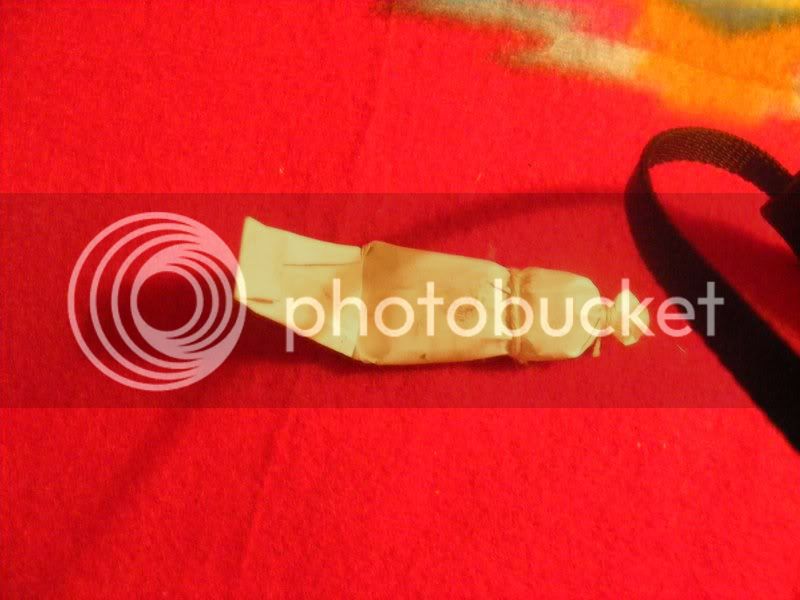Well, I finally got out to the range with the Indian Bess. I shot .690 and .735 balls, since the muzzleloading store near me was out of .715. I started out with 60 grains of FFG but after seeing no problems, quickly moved up to 80 grains. I used FFG in the pan as well and a 1" flint. For patching material I used cleaning patches that I use for my .30" rifles. Those probably weren't ideal, but they seemed to do a tolerable job of surrounding the ball and taking up the slack in the bore. I found that one surrounding a .735 ball gave a nice snug fit that required some effort to get down the bore. Two of them around a .690 ball was quite a bit looser. For lube I used olive oil.
First the good, the gun sparked well and I had no misfires at all until about 20 shots into the session. The misfire was due to the flint having lost it's edge. Now, I'd probably dry fired it a dozen times before getting to the range, so the flint actually went for about 32 shots before quitting. After about 12 shots I ran a swab soaked with CLP down the barrel a few times. I wasn't having any trouble loading or anything, but just figured it was a good idea.
I found it to be a fairly pleasant gun to shoot. Recoil was minimal even with the .735 balls and 80 grains of powder. The gun shot somewhat low and to the right, but I just adjusted my "sight picture" by holding high with the bayonet lug and lining the rear up on the left edge of the rear screw. That seemed to get me into the 6" circle at 25 yards. I didn't have the same luck at 50, but I'm guessing that some of that has to do with my loads and patches.
When ramming a ball down the barrel, it became fairly obvious that the bottom 12-15 inches is a few thousandths of an inch wider than the top. The ball would slide down with fairly uniform resistance until the last 14 inches or so and then it would suddenly become much easier to push. I'm not sure what effect this will have on accuracy, but I'm guessing it's better to have the barrel wider at the breech than at the muzzle and it would probably be better still to have a completely uniform barrel.
The trigger is still atrocious. I tweaked it a little bit more when I had the lock out for cleaning, but it's still not there yet. Right now it's smooth and HEAVY. I've reworked a lot of triggers in the past, so I'm pretty sure I can get this one to where I'll be happy with it. Between 5 and 10 pounds of pull will be fine.
So all in all, not a bad range session. Next time I'll get some 7.15 balls and some better patching material. I'm guessing that the gun is capable of much better accuracy than I achieved today. I might even rig up some temporary sights for testing purposes just in case my sighting technique is the problem. I'm normally quite good with iron sights, but a bayonet lug and a screw just don't allow for precision shooting.
First the good, the gun sparked well and I had no misfires at all until about 20 shots into the session. The misfire was due to the flint having lost it's edge. Now, I'd probably dry fired it a dozen times before getting to the range, so the flint actually went for about 32 shots before quitting. After about 12 shots I ran a swab soaked with CLP down the barrel a few times. I wasn't having any trouble loading or anything, but just figured it was a good idea.
I found it to be a fairly pleasant gun to shoot. Recoil was minimal even with the .735 balls and 80 grains of powder. The gun shot somewhat low and to the right, but I just adjusted my "sight picture" by holding high with the bayonet lug and lining the rear up on the left edge of the rear screw. That seemed to get me into the 6" circle at 25 yards. I didn't have the same luck at 50, but I'm guessing that some of that has to do with my loads and patches.
When ramming a ball down the barrel, it became fairly obvious that the bottom 12-15 inches is a few thousandths of an inch wider than the top. The ball would slide down with fairly uniform resistance until the last 14 inches or so and then it would suddenly become much easier to push. I'm not sure what effect this will have on accuracy, but I'm guessing it's better to have the barrel wider at the breech than at the muzzle and it would probably be better still to have a completely uniform barrel.
The trigger is still atrocious. I tweaked it a little bit more when I had the lock out for cleaning, but it's still not there yet. Right now it's smooth and HEAVY. I've reworked a lot of triggers in the past, so I'm pretty sure I can get this one to where I'll be happy with it. Between 5 and 10 pounds of pull will be fine.
So all in all, not a bad range session. Next time I'll get some 7.15 balls and some better patching material. I'm guessing that the gun is capable of much better accuracy than I achieved today. I might even rig up some temporary sights for testing purposes just in case my sighting technique is the problem. I'm normally quite good with iron sights, but a bayonet lug and a screw just don't allow for precision shooting.






